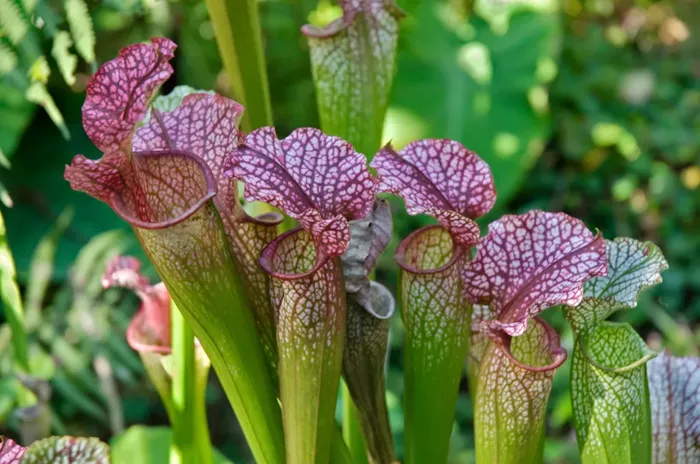Decorating your home for Halloween with spooky plants is a unique way to set a chilling atmosphere. From carnivorous plants to cobwebbed succulents, these eerie botanical choices will enhance the Halloween spirit and showcase some of nature’s most unusual creations.
Create a chilling display by placing these spooky plants on shelves and windowsills, or incorporate them into elaborate Halloween table settings. For a traditional Halloween look, combine pumpkins, squash, and gourds with dark foliage and flowering plants. Try ‘Black Forest’ coral bells heuchera, mondo grass, and oxalis. Deep purple flowers like the ‘bat flower’ and calla lily ‘Black Star’ will add an extra touch of eeriness to your porch or entrance.
If you’re ready to dive into the world of spooky plants, here are 12 of the best to elevate your Halloween decorations:
Black Bat Flower
Tacca chantrieri
This intriguing plant, known as the bat flower, features black, bat-shaped petals with brown or black bracts and long, whisker-like bracteoles. The plant stands about 25 inches tall and thrives in USDA zones 9b to 11. It prefers partial sun and well-drained, moist soil. Keep temperatures between 70-80°F (21-26°C), and avoid letting conditions drop below 55°F (12°C) to prevent damage.
Ghost Plant
Monotropa uniflora
Commonly known as the American Ice Plant or Indian Pipe, this plant has a single drooping, bell-like flower on a fleshy stem. Its white, translucent appearance gives it a ghostly look. It thrives in USDA zones 8-11, in full to partial sun and moist soil.
Dead Man’s Fingers
Decaisnea fargesii
The Blue Bean Shrub, or Decaisnea fargesii, produces elongated fruits resembling giant fingers. These pale blue pods are filled with a sticky jelly surrounding large seeds. This deciduous shrub grows 13-26 feet tall and needs a sheltered spot with partial shade or full sun and well-drained soil.
Sempervivum Cobweb
Sempervivum arachnoideum
The Sempervivum Cobweb, or Houseleek, features rosettes of fleshy green leaves covered in fine, white fibrous hairs that resemble a spider’s web. It thrives in full sun and well-drained soil, making it suitable for indoor and outdoor use. This hardy plant produces small pink flowers in the summer.
Sweet Betsy Trillium
Trillium
Despite its charming name, the Sweet Betsy Trillium has a peculiar appearance. It features deep burgundy flowers that bloom from a cluster of three leaves, resembling a toad’s skin. These perennials are ideal for shaded woodland gardens and can grow 12-18 inches tall.
Old Man Cactus
Espostoa melanostele
Named for its long white hairs, resembling a beard, the Old Man Cactus has a ghostly appearance. This slow-growing cactus is perfect for bright indoor spaces and requires minimal watering. However, avoid overwatering to prevent rot, and keep temperatures above 54°F (12°C).
Toad Plant
Stapelia gigantea
The Toad Plant, or Stapelia gigantea, is known for its creepy, tongue-like petals and unpleasant odor. Its star-shaped blooms are pale yellow with purple stripes, making it a striking addition to spooky indoor gardens.
Pitcher Plant
Nepenthes
The Nepenthes, or tropical pitcher plant, features curvy, red and yellow-green pitchers that hang from the plant. These carnivorous plants trap insects in their nectar-filled pitchers, which digest the prey. They prefer warm, humid conditions and can take 5 to 10 years to mature.
Red Cockscomb
Celosia cristata
The Red Cockscomb plant is notable for its contorted, velvety flowers that resemble brains. This plant is easy to grow and retains its vivid color even when cut, making it ideal for Halloween decorations. It prefers full sun and well-drained soil.
Sarracenia
Sarracenia drummondii
The Sarracenia, or crimson pitcher plant, has tall, veiny, red-tipped pitchers that can reach up to 3 feet tall. It thrives in warm climates or in shady areas during cooler months. This plant requires high humidity and warm temperatures.
Venus Flytrap
Dionaea muscipula
The Venus Flytrap is known for its snapping leaves that trap and digest insects. It grows well in full sun and part shade, and can reach 6-12 inches in height. This plant is native to bogs and requires acidic soil.
Thread-leaved Sundew
Drosera tracyi
The Thread-leaved Sundew has sinewy leaves covered in sticky hairs that trap and digest insects. It thrives in high humidity and bright light, reaching up to 10 inches tall.
Spooky plants can turn any space into an eerie landscape, whether you’re drawn to their dark blooms or their insect-eating habits. For more unusual plants, consider exploring carnivorous varieties, lithops (living stones), and the fascinating habits of air plants.
Related topics:
- Fall: The Ideal Season for Planting Spring Bulbs
- How Plants Prevent Viruses from Passing to Their Offspring
- Unusual Plants: The Strange Gourd and the Eight-Headed Sunflower


